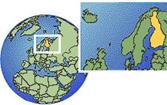Archive for the ‘Finland’ Category
Learn Your Place
 A cardinal rule in genealogy is to learn all you can about the places your ancestors resided. Normally I have not had trouble doing this, and I readily have found information on many places over the years of my research.
A cardinal rule in genealogy is to learn all you can about the places your ancestors resided. Normally I have not had trouble doing this, and I readily have found information on many places over the years of my research.
This year, however, I have encountered difficulty as I have tried to trace my Finnish heritage. Their history is so complicated, and so much depends on geography. I have yet to find a Finnish gazeteer or a good map.
I never feel comfortable adding new ancestor names to my database until I am reasonably sure they are actually my ancestors. If a purported husband and wife came from different villages, I want to know how close they were. Or in the words of genealogist Pat Hatcher, were they in “kissing distance”? I need a good tool for identifying place names and locations.
So far, I have struggled along with little snippets of maps from various Finnish websites. The Family Search wiki (https://familysearch.org/learn/wiki/en/Main_Page) has helped with place names in church parishes. Still, I wish I had the right tools to find my place.
Myllynen or Myllyin?
 My great-grandfather Alexander Mattila’s 1945 death certificate states that his mother was “Lizza Myllyla” of Finland. His American-born daughter was the informant.
My great-grandfather Alexander Mattila’s 1945 death certificate states that his mother was “Lizza Myllyla” of Finland. His American-born daughter was the informant.
As I researched Alex, I found that this information conflicts with his baptism record from Finland’s Viipuri parish. That record says her name was “Elisabeth Myllynen”. The discrepancy needs an explanation.
I do not know much about Finnish ways, but it seems that “Lizza” must have been a nickname for “Elisabeth”. No real problem there, but what about the difference in surnames?
I searched for more evidence by locating the baptism records for Alexander Mattila’s many sisters. Not all the records provided a surname for her. Those that did variously gave her last name as “Myllynen” or “”Myllyin”. While it appears I can discard the “Myllyla” variation as something created by a granddaughter who never met her grandmother, I now had a new problem. Was the surname “Myllynen” or “Myllyin”?
I worked back to locate Elisabeth’s marriage record. There her name was “Myllyin”.
Next I needed to find her birth record for additional documentation. The Finnish Communion Books for Elisabeth Myllynen’s household 1887-1896 provided a birthdate for her, 25 April 1835. A search of Viipuri birth and baptism records for an Elisabeth born that day found only one likely candidate, Elisabeth, daughter of Simon Mattson and Sofia Henr:dr of the Myllynen house in the village of Tervajärvi. This highly-probative record indicates that her name was probably “Myllynen” rather than “Myllyin”, and that is the name I added to my database.
But then I began researching her father, Simon Mattson. All the church records for him gave his surname as “Myllyin”, not “Myllynen”. Again the question arises, what was the family name?
I cannot reconcile this discrepancy. I think I have found distinct people on these records that have gone by two similar surnames. I believe that perhaps the names were used interchangeably in the 19th century. Finland still had a mostly patronymic system then, and surnames did not have the importance we give to them today. Spelling probably was not yet standardized.
This is the best explanation I can devise. I am not completely satisfied with it. I plan to consult my Finnish friends to see if they can provide any more information on this issue of these surnames. Name discrepancies are red flags that one may be researching the wrong ancestors. I do not want to waste time doing that.
Why I Have Not Done a DNA Test
 Everyone seems interested in testing their DNA these days. Genealogists in particular flock to companies offering these tests. Why do they want DNA tests, and why have I not joined the throng?
Everyone seems interested in testing their DNA these days. Genealogists in particular flock to companies offering these tests. Why do they want DNA tests, and why have I not joined the throng?
This week our local Computer Interest Group met to hear genealogist Ric Morgan speak about DNA testing. He described the three types of tests available: Y DNA, mitochondrial DNA, and autosomal DNA. Over the past decade, the cost of these tests has come down even as the scientific potential of them has grown. Still, I cannot bring myself to mail in that cheek swab.
Here’s why:
- Y DNA testing is for men only, so I obviously cannot do this one. This test can identify those men among us who are related to one another and who descend from common male ancestors. In my own family, my father’s first cousin Leslie Reed submitted a sample several years ago. This tied us in to the family of Thomas Reed of colonial Morris County, New Jersey. The puzzle now is to sort out all the Reeds in New Jersey at that time and document the families. At this point, we need no further Y DNA testing.
- Mitochondrial DNA traces the direct female line. Mine goes back to Finland. We have had substantial success documenting my Finnish lines without resorting to DNA testing. Because mine is a small family, I have been in touch with most of my American relatives of Finnish descent. I do not know any current family members in Finland, but I also do not think the current DNA databases contain many native Finns who would be possible matches for me. Submitting a mitochondrial DNA test would not tell me more than I already know, especially about my direct lineage.
- Autosomal DNA offers the new frontier in DNA testing according to Ric Morgan. It also poses the greatest privacy threat. Autosomal DNA contains the complete genetic record for an individual. Wouldn’t insurance companies or the government love to get their hands on that! I go to great lengths to protect my privacy, so this test poses no temptation for me. I will keep looking for another way to identify the man who fathered my paternal grandmother in rural Nebraska sometime in 1895.
So there you have it. I plan to keep my DNA untested because the sex-linked tests would be of no immediate value to me. I am unwilling to open the autosomal test door. I will keep doing genealogy the old-fashioned way, one document at a time.
Where Did Grandma Live?
 My second great-grandmother Elisabeth lived somewhere in Finland’s Viipuri parish in the 19th century. As I research her family I want to pinpoint her residence. Church records for her family reveal that they lived in the Myllynen/Myllyin house. They adopted this house name as their surname when they abandoned Finland’s patronymic naming system.
My second great-grandmother Elisabeth lived somewhere in Finland’s Viipuri parish in the 19th century. As I research her family I want to pinpoint her residence. Church records for her family reveal that they lived in the Myllynen/Myllyin house. They adopted this house name as their surname when they abandoned Finland’s patronymic naming system.
So where do I find this house? The Viipuri parish records for the family also name its location, the village of Tervajärvi, or Tar Lake. Where is that? It turns out that I will encounter trouble identifying this place:
- Of course I go first to Google maps. There I received many hits for Tervajärvi, Finland. After sifting through the list, I find that none of these seems to be near Viipuri (which is now known as Vyborg, Russia).
- How about a search for Tervajärvi, Russia? There I get one result, in Russian Karelia some distance northeast of Vyborg. This is a possibility, but I do not know whether this Tervajärvi lies within the old Viipuri parish boundary. It seems the Finns used the same place names for many locations.
- Wikipedia has a list of rural municipalities in the old Viipuri province, but Tervajärvi did not make the list.
- What to do next? I remembered that my husband/tech advisor has already done quite a bit of research locating my ancestral places as he plans our upcoming trip to Finland. He has sent me at least 15 small maps showing many of these in the Viipuri area. I pull up his maps, but I cannot see Tervajärvi on any of them.
- A gazetteer for Finland or Russia might help, but I cannot find one online or in any of the local libraries. It seems like I am out of options.
- Then I remember another place I could try. The Denver Public Library (DPL) has some very detailed maps prepared by the CIA in the 1990’s. I quick look in the online DPL catalog tells me that they do have CIA maps for Finland and Russia. Perhaps my Tervajärvi will appear on one of those. I plan to visit DPL next week to find out.
In the meantime, if anyone knows the precise location of the Myllyin house in the village Tervajärvi near Viipuri/Vyborg, please let me know. My question remains, “Where did Grandma live?”
A Handy Tool for Genealogists
 One of my favorite things to do as a genealogist is to look at cemetery markers and death records. If I am lucky, I will find birth and death dates for the deceased here. Yet sometimes, especially in earlier records, I find the birth date omitted. The death record may give only the death date coupled with the age of the deceased.
One of my favorite things to do as a genealogist is to look at cemetery markers and death records. If I am lucky, I will find birth and death dates for the deceased here. Yet sometimes, especially in earlier records, I find the birth date omitted. The death record may give only the death date coupled with the age of the deceased.
I encountered this recently when I studied the church burial record for my Finnish ancestor Anders Abelsson Mattila. He had died on the 27th of April, 1882 at the age of 55 years, 5 months, and 23 days. The record did not provide a birth date for him.
In my early days of genealogy, I would have had to pursue a complicated formula to derive his birth date from the information on this record. No more. Now I can use a simple utility found on Search For Ancestors at http://www.searchforancestors.com/utility/birthday.html to calculate this date. The Tombstone Birthday Calculator on this site allows me to plug in the death date and age information, and then it calculates the birth date for me.
Using this tool, I learned that Anders was born 4 November 1826. This information exactly matches the date given on all his subsequent records. The quick answer I received from the online calculator gave me another rewarding experience analyzing a death record. You can bet I have this Calculator bookmarked as part of my genealogical tool kit.
We Find My Anders Abelson
 My mother’s family came from Finland, and I plan to travel there later this year. I want to visit my ancestral area.
My mother’s family came from Finland, and I plan to travel there later this year. I want to visit my ancestral area.
According to family lore, my immigrant great-grandfather was the son of Andrew Mattila, and he was from Viipuri, Finland. The family also had the names of several other Viipuri family members who had come to the United States. With this information, we identified my Andrew Mattila family in the Viipuri area at the end of the nineteenth century.
He was known in Finland, not as Andrew, but by either the Finnish or Swedish versions of his first name, Antti or Anders. We also learned that in his earlier years, he went by his patronymic name, Anders Abelson, meaning his father’s first name was Abel.
Anders/Antti/Andrew lived and worked in the Viipuri parish from the time of his marriage. Was he born there, too? We wanted to find his birth record to see whether we needed to visit any place besides Viipuri, now Vyborg, Russia. Luckily, many of these records can be found online at http://www.genealogia.fi/hiski.html.
An initial search for an “Anders son of Abel in Viipuri parish” turned up a single candidate. Anders Abelson, son of Abel Ivoinson, was born at the Huumola village near Viipuri on 23 November 1827.
Unfortunately, his birth date did not match all the other records we had for my Anders. The Communion Book records for my Anders’ family and his death registration all report he was born in 1826, not 1827.
Is he my ancestor? I suppose we could assume that being off by a year could be a reasonable mistake, but I was not satisfied with that explanation. I thought we needed to do a more exhaustive search. I wanted evidence that either corroborated or disputed the link between the Anders Abelson we found in Huumola and my family.
We broadened our online search to include all of Finland. Sure enough, we found another Anders Abelson in the Lapinjärvi Municipality some distance west of Viipuri. This boy was the son of Abel Andersson and Greta Caspersdotter, and they lived on the Mattila farm. He was born on 4 November 1826, the exact date reported in the Communion Books for my Anders Abelson Mattila. I believe this is my guy.
When we go to Finland, we can take a train ride from Helsinki through the Lapinjärvi area. My Finnish grandmother’s paternal roots are there.
Genealogy Delayed, Again
 I try to set aside my mornings to pursue my genealogy. If I do that regularly, genealogy becomes a half-time job for me. I should be able to do a lot of research and writing.
I try to set aside my mornings to pursue my genealogy. If I do that regularly, genealogy becomes a half-time job for me. I should be able to do a lot of research and writing.
Unfortunately, that never seems to happen. Day after day, real life interferes, and I cannot stay on schedule. Take this week, for example:
- On Monday I was pressed into babysitter duty for my one-year-old granddaughter. Trust me, you cannot do genealogy and watch her at the same time. I did manage to clear out my e-mail during her 45-minute nap.
- On Tuesday I spent most of the day working on financial matters, my own and my father’s. I could have been at the Denver Public Library for a morning meeting of the Germanic Genealogical Society of Colorado, but the weather was terrible that day. I did not want to make the 45-minute drive. Besides, financial matters needed attention.
- On Wednesday, see Monday.
- On Thursday (today), I finally have the morning to myself. I will blog, update our webtree, and see what I can find on my Finnish great-great-grandfather Anders/Antti Abelson Mattila.
- On Friday, babysitting again, for a grandson this time. As a Terrible Two, he will need my full attention. I will be lucky to manage my e-mail with him around.
So this week, which is fairly typical, I have one morning to work on the genealogy-related things I want to do. I could always carve out more time by saying no to the babysitting requests, but I will not. I love every opportunity I can get to play with the little ones. Instead of spending all my mornings with my dead ancestors, I think it equally important to spend time with the living generations. The dead ones will just have to wait.
The Push and The Pull
 My mother’s grandparents emigrated from the Nordic countries in the early 20th century. I know a lot about their lives in America but not so much about their lives in the old country. They were young married couples when they arrived in the United States. Immigrants are said to have been pulled here because they wanted a better life. But what, exactly, did they leave behind? What pushed them away from their homeland?
My mother’s grandparents emigrated from the Nordic countries in the early 20th century. I know a lot about their lives in America but not so much about their lives in the old country. They were young married couples when they arrived in the United States. Immigrants are said to have been pulled here because they wanted a better life. But what, exactly, did they leave behind? What pushed them away from their homeland?
Family members spoke of how my Norwegian ancestors, Ole Bentsen and Sofie Sivertsdatter, had left their home farms in Bø and Eidsfjord when they grew up to find work in Stokmarknes, a larger city in the Vesterålen District of Norway. What did they do there? Both were literate but had no higher education. They must have worked as laborers of some sort. Stokmarknes lies in the cod fishing area of Norway, so perhaps Ole worked on a boat, a trade he could have learned from his fisherman father.
What did Sofie do? Domestic help? Fish processing? I know she had some baking skills. After she settled on a Montana homestead, she made bread not only for her own family but also for a bachelor neighbor. I also know that just before moving to Stokmarknes, she had tended sheep on her uncle’s place. Maybe she put those skills to use on one of the farms surrounding Stokmarknes. Bervik perhaps, where she lived in the months after her marriage and where her daughter Riborg was born.
I know less about the background of my Finnish ancestors, Alexander Mattila and Ada Alina Lampinen. They said only that they were from Viipuri which was the second-largest city in Finland at the time. In looking at their records, I find that neither of them was born there. It appears that they, too, were born elsewhere, Alex in the rural parish southeast of Viipuri, and Ada in Juuka parish north of there. As young adults they, too, went to the closest city, Viipuri, probably to find work.
So what work did they do? Alex was listed as a laborer when he emigrated, but no particular line of work was specified. Later in life, he worked as a carpenter. I do not know whether he acquired that skill in Finland or in the United States.
As for Ada, I do not know what she may have done in Viipuri. Worked in a shop? Domestic help? My mom remembered her baking skills—homemade bread and cakes.
Both of these couples worked hard, but obviously they saw no opportunity in their home countries. They felt the push of wanting something better. The Norwegians wanted their own land, impossible to acquire as part of the laboring class in Norway. The Finns may have wanted to get away from their strife-torn country that suffered from hunger and disease. Under the harsh rule of the Russian czar, worker unrest was brewing, food was scarce, and public health did not seem to be a priority. Alex’s father and one sister had both died of tuberculosis.
So America beckoned. Ole and Sofie followed their dream to live in a country that gave away land to people willing to work had for it. Relatives in America urged Alex and Ada to come and settle in a healthy Finnish community in Minnesota where there was plenty of work, food, and political stability. Both couples saved their money and took steamships to a new land to build a new life. And they never talked much about the old one.
New Year, New Project
 As I do every year, I chose one family line for my research focus in 2014. This year my husband/tech advisor and I plan to take a trip to Finland, so guess what? I will target my research on my Finnish line. Two of my great-grandparents emigrated from Finland in 1905.
As I do every year, I chose one family line for my research focus in 2014. This year my husband/tech advisor and I plan to take a trip to Finland, so guess what? I will target my research on my Finnish line. Two of my great-grandparents emigrated from Finland in 1905.
I worked on them once before, a couple of years ago. At that time, I pretty well fleshed out my great-grandfather Alexander Mattila’s birth family. He was from the area outside Viipuri, then Finland’s second-largest city. Today, the city lies in Russia and is known as Vyborg. We plan to take a canal cruise to see Vyborg while we are in Finland.
My great-grandmother, Alex’s wife, was Ada Alina Lampinen. I think she came from the Kuopio area of Finland. She presents a more difficult research subject than her husband Alex did. Their eldest daughter, my grandmother, knew a lot about her father’s family, and she passed that information along to me. Not so with her mother’s family. All she could say was that her mother was the only member of her family to emigrate, and she knew nothing of those who remained behind.
Obviously, then, my goal is to learn more about Ada’s family this year. Lampinens, I am on my way to find you. I do not want to be visiting the wrong places when I take my trip.
Celebrating on October 31
 Today is All Hallows Eve, or Halloween, a secular name by which it is more commonly known. People will dress up in costumes and celebrate at parties complete with jack-o-lanterns, ghosts, spiders, witches, etc. My young grandchildren can hardly wait to rake in the candy when they go out trick-or-treating tonight.
Today is All Hallows Eve, or Halloween, a secular name by which it is more commonly known. People will dress up in costumes and celebrate at parties complete with jack-o-lanterns, ghosts, spiders, witches, etc. My young grandchildren can hardly wait to rake in the candy when they go out trick-or-treating tonight.
Yet October 31 historically has had a much more religious significance. Christians have long kept vigil this night for the observance of All Saints Day tomorrow.
Of even more significance to my family is that October 31 marks the beginning of the Protestant Reformation. On All Hallows Eve in 1517, Martin Luther nailed his 95 theses on the door of Wittenberg Church to protest the excesses of the Roman Catholic Church. This shocking act marked the beginning of the Reformation and the Lutheran faith.
Luther’s teaching spread far, and the Nordic countries quickly left the Roman church to embrace Lutheranism. My mother’s family in Norway and Finland followed the state-mandated Lutheran tradition for hundreds of years.
The Lutheran church records in these countries still exist. They provide valuable genealogical information to me in their lists of baptisms, confirmations, marriages, and burials. With these records, I can trace my family back many generations relatively easily.
So Halloween means more to me than just another secular party day. In addition to All Hallows Eve, it is the birthday of the Lutheran church. This year my Lutheran congregation celebrated, not with candy and costumes, but by performing Bach’s cantata #80 based on the great hymn of the Reformation, A Mighty Fortress Is Our God. I celebrate Reformation Day today, not just Halloween.